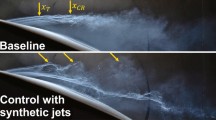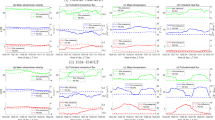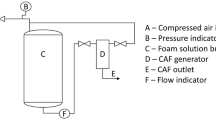Abstract
A set of experiments has been conducted on a medium-scale propane fueled pool fire acoustically forced in order to facilitate repeatable measurements defining the flame’s transient behavior. The fuel flow was slightly perturbed at the pool fire’s natural frequency by a sine waveform driven with a loudspeaker which was installed under the burner. As a result of the perturbation, the puffing behavior of the pool fire and the fire shape were modified. As the magnitude of the sine wave was increased larger perturbations were clearly observed, based on the measurement of the radiative heat flux and image analysis. Temperature and soot volume fractions were measured along the center line and throughout a slice of the flame. The soot volume fractions in the flame region are in good agreement with the data of other researchers. The reproducibility of these measurements was established through several experiments. The acoustically driven flame provides the possibility of more repeatable measurements of the transient behavior of these pool fires.
Similar content being viewed by others
References
E. J. Weckman and A. B. Strong, Experimental investigation of the turbulence structure of medium-scale methanol pool fires, Combust and Flame, 105 (1996) 245–266.
M. Hertzberg, K. Cashdollar, C. Litton and D. Burgess, The diffusion flame in free convection, U.S. Bureau of Mines, Report Number RI8263, Washington, D.C. (1978).
A. Schonbucher, W. Brotz, C. Balluff, G. Riedel, A. Kettler and N. Scheiss, Visualization of organized structures in buoyant diffusion flammes, Ber. Bunsenges. Phys. Chem., 89 (1985) 595–603.
A. Hamins, J. C. Yang and T. Kashiwagi, An experimental investigation of the pulsation frequency of flames, Twenty-Fourth Symposium (International) on Combustion, The Combustion Institute (1992) 1695–1702.
J. Buckmaster and N. Peters, The infinite candle and its stability-A paradigm for flickering diffusion flames, Twenty-First Symposium (International) on Combustion, The Combustion Institute (1986) 1829–1836.
M. Centegen Baki and A. Ahmed Tarek, Experiment on the periodic instability of buoyant plums and pool fires, Combustion and Flame, 93 (1993) 157–184.
J. X. Wen, K. Kang, T. Donchev, J. M. Karwatzki, Validation of FDS for the prediction of medium-scale pool fires, Fire Safety Journal, 42 (2007) 127–138.
M. Muñoz, E. Planas, F. Ferrero and J. Casal, Predicting the emissive power of hydrocarbon pool fires, Journal of Hazardous Materials, 144 (2007) 725–729.
P. K. Raj, Large hydrocarbon fuel pool fires: Physical characteristics and thermal emission variations with height, Journal of Hazardous Materials, 140 (2007) 280–292.
E. J. Weckman and A. Sobiesiak, The oscillatory behaviour of medium-scale pool fires, Twenty-Second Symposium (International) on Combustion, The Combustion Institute. (1989) 1299–1320.
J. H. Kent and H. GG. Wagner, Temperature and fuel effects in sooting diffusion flames, Twentieth Symposium (International) on Combustion, The Combustion Institute (1984) 1007–1015.
M. Y. Choi, A. Hamins, G. W. Mulholland and T. Kashiwagi, Simultaneous optical measurement of soot volume fraction and temperature in premixed flames, Combustion and Flame, 99 (1994) 174–186.
C. L. Tien and S. C. Lee, Flame radiation, Prog. Energy Combust. Sci., 8 (1982) 41–59.
W. H. Dalzell and A. F. Sarofim, Optical constant of soot and their application to heat-flux calculations, Journal of Heat Transfer, 91 (1969) 100–104.
M. Y. Choi, A. Hamins, H. Rushmeier and T. Kashiwagi, Simulateous optical measurement of soot volume fraction, temperature, and CO2 in heptane pool fire, Twenty-Fifth Symposium (International) on Combustion, The Combustion Institute (1994) 1471–1480.
B. J. McCaffrey, Purely buoyant diffusion flames: some experimental results, National Bureau of Standards Report NBSIR-79-1910, Washington, D.C. (1979).
E. Gengenbre, P. Cambray, D. Karmed and J. C. Bellet, Turbulent diffusion flames with large buoyancy effects, Combustion Science and Technology, 41 (1984) 55–67.
T. L. Henriksen, G. J. Nathan, Z. T. Alwahabi, N. Qamar, T. A. Ring and E. G. Eddings, Planar measurements of soot volume fraction and OH in a JP-8 pool fire, Combustion and Flame, 156 (2009) 1480–1492.
Author information
Authors and Affiliations
Corresponding author
Additional information
This paper was recommended for publication in revised form by Associate Editor Oh Chae Kwon
Ki Yong Lee received B.S. from Inha University in 1986 and M.S. and Ph.D in mechanical engineering from the University of Illinois at Chicago, USA in 1992 and 1995. He is currently Professor at ME, Andong National University, Korea. His research interests are in pollutant formation during hazardous waste incineration, reduction of detailed chemical kinetic mechanism and their application, investigation of NOx reduction in an acoustic and an electric field, fluid dynamics of multiphase chemically reacting flows.
Andrew Lock graduated as a mechanical engineer from the University of Illinois in 2002. He received his Master’s degree in 2004, and his Ph.D in 2007 from the same school. He joined the National Institute of Standards and Technology in 2007 where he worked on projects in thermal imaging camera characterization, full scale fire behavior, and underventilated compartment fires. He has conducted and published papers on numerous bench scale, room scale, and field fire experiments related to combustion and fire dynamics.
Anthony Hamins is Chief of the Fire Research Division at the National Institute of Standards and Technology (NIST). Prior to joining NIST in 1989, Hamins was a Postdoctoral Research Engineer at the University of California at San Diego and a Research Scientist in the Chemistry Department at George Washington University in Washington, D.C. His research interests include measurement science applied to heat and mass transfer in fires of multiple scales, fire investigation, combustion kinetics, fire model validation, and structural fire resistance.
Rights and permissions
About this article
Cite this article
Lee, K.Y., Lock, A. & Hamins, A. An experimental study of acoustically driven medium-scale pool fires. J Mech Sci Technol 25, 2035–2041 (2011). https://doi.org/10.1007/s12206-011-0627-1
Received:
Revised:
Accepted:
Published:
Issue Date:
DOI: https://doi.org/10.1007/s12206-011-0627-1




